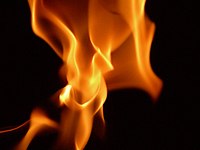
Photo from wikipedia
Abstract The process of decomposition of organochlorine compounds by a three-phase ac plasma torch with vortex arc stabilization is studied. The plasma torch had two zones for introducing the plasma-forming… Click to show full abstract
Abstract The process of decomposition of organochlorine compounds by a three-phase ac plasma torch with vortex arc stabilization is studied. The plasma torch had two zones for introducing the plasma-forming media: the near-electrode and arc-burning zones. The near-electrode zone was fed with a shielding gas, and the arc-burning was fed with water vapor, methane, and vapors of organochlorine compounds. The resulting products were analyzed using mass spectrometry, XRD, scanning electron microscopy, and IR spectroscopy. In an experiment with chlorobenzene and carbon tetrachloride, in the gaseous and liquid fractions, only one chlorine-containing compound, HCl, was detected. However, in the experiment with chlorobenzene, the soot yield was 0.98 wt % of the raw material and the chlorine content in the soot was 1.61%. IR spectral data confirm the presence of the Cl–O and Cl–С bonds.
Journal Title: Technical Physics
Year Published: 2020
Link to full text (if available)
Share on Social Media: Sign Up to like & get
recommendations!